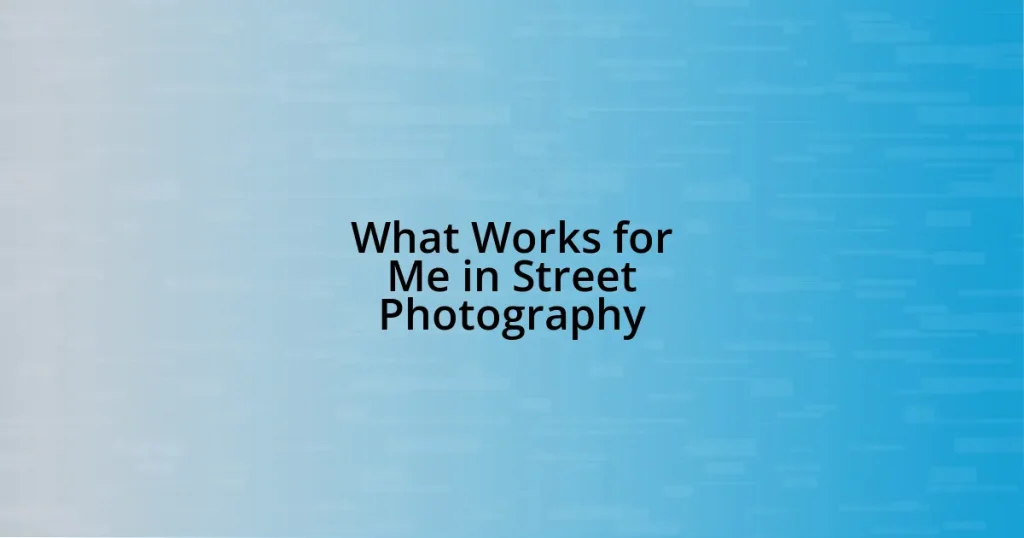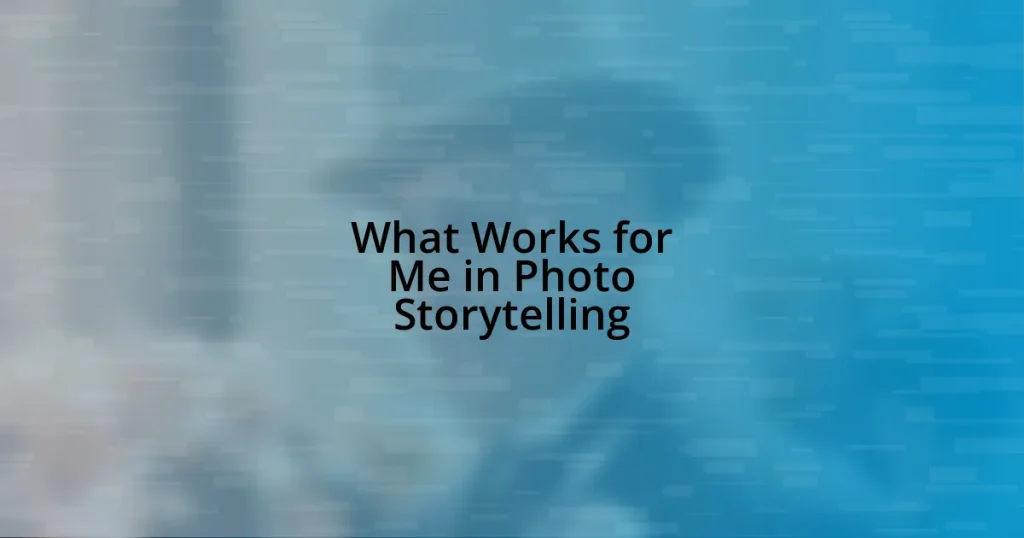Key takeaways:
- Finding inspiration can come from everyday moments and intimate connections rather than just grand landscapes.
- Developing a personal style is an evolving process shaped by experimentation and reflection on past work.
- Mastering technical skills liberates creative expression and enhances storytelling in photography.
- Sharing work effectively involves crafting thoughtful narratives, knowing your audience, and engaging with feedback for growth.

Finding inspiration in photography
I find inspiration in the world around me, often in the most unexpected places. One rainy afternoon, I ventured out to photograph the droplets on my window. The way light refracted through them reminded me that beauty can emerge from gray and gloomy skies.
Sometimes, I wander into local markets or parks, feeling the pulse of the community. I remember capturing the laughter of children playing; the essence of joy was so palpable. Isn’t it fascinating how a single moment, a shared smile, can speak volumes without uttering a word?
My travels have also broadened my perspective. In a tiny village in Italy, an elderly woman taught me how to see the stories etched on people’s faces. Each wrinkle told a tale, each smile held a secret. It’s moments like these that remind me: inspiration isn’t just found in grand landscapes or striking colors but in the quiet, intimate connections we forge with others.

Understanding your unique perspective
Understanding your unique perspective means recognizing that your vision shapes your art. I recall a late evening walk through my neighborhood; the golden hour cast a warm glow on everyday scenes. While others saw mundane streets, I found narratives in the shadows and light interplay. That moment of clarity was powerful—it reinforced how my personal experiences color my photography.
Here are some ways to tap into your unique perspective:
– Reflect on your background and experiences that shape how you see the world.
– Engage with your surroundings; what makes your heart race or your spirit feel buoyant?
– Experiment with different styles until something resonates deeply with you.
– Pay attention to the emotions evoked by your subjects—these feelings can guide your storytelling.
– Don’t shy away from imperfections; they often provide the most authentic expression of your viewpoint.
Finding my voice was a journey of exploration; it led me to appreciate the overlooked details. Each photograph became a reflection of who I am and how I see life, reminding me that there’s beauty in embracing my individuality.

Developing a personal style
Developing a personal style is one of the most rewarding parts of my photographic journey. I’ve experienced firsthand how experimenting with various techniques and subjects can lead to unique visual language. For instance, I remember the time I decided to focus exclusively on black-and-white photography for a month. At first, it felt restrictive, but as I delved into contrasts and textures, I discovered an emotional depth in my images that I hadn’t noticed before.
During my exploration, I also learned that a signature style doesn’t happen overnight; it’s an evolving process. Reflecting on my early work, I see a blend of influences that shaped my early captures—everything from vibrant street portraits to soft, pastoral landscapes. Over time, I’ve gravitated toward more intimate scenes, often preferring to immerse myself in quieter moments. It’s fascinating how our journeys through life can mold our artistic expressions, transforming the way we view and present the world around us.
To illustrate the evolution of style, consider the following comparison of different approaches I took while honing my photography:
| Approach | Outcome |
|---|---|
| Bright, Colorful Landscapes | Vibrant, lively imagery |
| Intimate Portraits | Emotional depth and connection |
| Abstract Shapes and Patterns | Unique interpretations of everyday objects |
| Black-and-White Focus | Heightened contrast, dramatic storytelling |

Mastering technical skills
Mastering technical skills in photography is truly a pivotal part of finding your voice. I remember the overwhelming feeling when I first picked up my DSLR camera; it seemed like a high-tech puzzle! Learning about exposure, aperture, and shutter speed felt daunting, but I soon realized that mastering these elements allowed me greater freedom to express the stories I wanted to tell through my lens. Have you ever found yourself at a moment where understanding the technical side suddenly clicked?
As I dove deeper, I discovered that practicing with different settings in various environments opened up new creative possibilities. I recall a particularly rainy day when I decided to embrace the weather. Armed with my knowledge of ISO and exposure compensation, I captured droplets clinging to vibrant petals. That day, I transformed challenges into opportunities, realizing that technical proficiency liberated my creative instincts rather than constraining them. It was liberating to see how, once I became comfortable with the tools at my disposal, my artistic vision flourished.
Reflecting on my journey, I believe that technical skills should never feel like a chore; rather, they are stepping stones to artistic expression. Each time I ventured out with my camera, I approached it like an artist wielding a brush—technical skills become the foundation upon which creativity builds. So, as you explore your photography, ask yourself: how might every new skill elevate your storytelling? The answer is often more profound than you might expect.

Experimenting with different genres
Diving into different genres was like opening a treasure chest for me. I remember the thrill of picking up my camera and wandering into a local street fair, where I transitioned from landscape photography to capturing candid moments of joy and laughter. Each click of the shutter brought forth new emotions; the colors of the fair, the expressions on people’s faces, and the spontaneity of life added a vibrancy that was intoxicating. Did you ever think about how a single event can usher you into entirely new photographic realms?
When I tried my hand at macro photography, it felt like stepping into an alien world. I still vividly recall the day I spent hours photographing dew-kissed flowers, marveling at the delicate details that often go unnoticed. It challenged my perception of both nature and the art of photography itself. The close-ups revealed such intricate textures and colors, helping me appreciate the beauty around me on a deeper level. How has trying something new expanded your perspective in ways you never anticipated?
Exploring portrait photography was another turning point in my journey. I remember a young girl whose laughter was contagious. It wasn’t just about capturing her image; it was about the story behind her eyes. My heart raced as I focused on getting that perfect moment where her joy was palpable. That experience taught me the power of connection—every genre has a unique way of engaging both the photographer and the audience. Can you think of a genre that drew you in simply because of the stories it had to tell?

Sharing your work effectively
Sharing your work effectively goes beyond just hitting “post” on social media. I remember the first time I shared a photo I was truly proud of on Instagram. Instead of just dropping it into my feed, I took time to craft a thoughtful caption that explained the story behind the image. That experience taught me how important it is to give context, allowing viewers to connect with the emotions I felt while capturing that moment. Have you ever noticed how a well-told story can make an image resonate more deeply?
Another key aspect is knowing your audience. I discovered that tailoring my content to suit the platforms I shared on made a big difference. For instance, the narrative I shared on my blog was richer and more detailed, while I kept my Instagram posts visually focused, letting the photos speak for themselves. This balancing act helped engage different communities and showcased my perspective in various ways. Have you thought about how your voice can shift depending on where you share your work?
Finally, feedback can be an excellent tool for growth and connection. I remember feeling nervous when I started sharing my photography in online forums. However, the constructive criticism and encouragement I received not only helped me improve but also fostered relationships with fellow photographers. Engaging with others on their work and sharing insights created a community where we all felt inspired and motivated. How has feedback shaped your journey in photography?
















